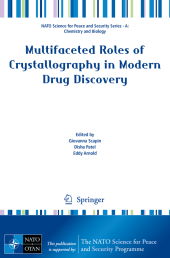 Neuerscheinungen 2015Stand: 2020-02-01 |
Schnellsuche
ISBN/Stichwort/Autor
|
Herderstraße 10
10625 Berlin
Tel.: 030 315 714 16
Fax 030 315 714 14
info@buchspektrum.de |

Eddy Arnold, Disha Patel, Giovanna Scapin
(Beteiligte)
Multifaceted Roles of Crystallography in Modern Drug Discovery
Herausgegeben von Scapin, Giovanna; Patel, Disha; Arnold, Eddy
2015. 2015. xi, 240 S. 18 SW-Abb., 89 Farbabb. 235 mm
Verlag/Jahr: SPRINGER NETHERLANDS; SPRINGER 2015
ISBN: 9401797242 (9401797242)
Neue ISBN: 978-9401797245 (9789401797245)
Preis und Lieferzeit: Bitte klicken
The present work offers a snapshot of the state-of-the-art of crystallographic, analytical, and computational methods used in modern drug design and development. Topics discussed include: drug design against complex systems (membrane proteins, cell surface receptors, epigenetic targets, and ribosomes); modulation of protein-protein interactions; the impact of small molecule structures in drug discovery and the application of concepts such as molecular geometry, conformation, and flexibility to drug design; methodologies for understanding and characterizing protein states and protein-ligand interactions during the drug design process; and monoclonal antibody therapies. These methods are illustrated through their application to problems of medical and biological significance, such as viral and bacterial infections, diabetes, autoimmune disease, and CNS diseases. As approaches to drug discovery have changed over time, so have the methodologies used to solve the varied, new, and difficult problems encountered in drug discovery. In recent years we have seen great progress in the fields of genetics, biology, chemistry, and medicine, but there are still many unmet medical needs, from bacterial infections to cancer to chronic maladies, that require novel, different, or better therapies. This work will be of interest to researchers and policy makers interested in the latest developments in drug design.
Preface.- List of Contributors.- Engineering G Protein-Coupled Receptors for Drug Design ; M. Congreve et al.- Structural Insights into Activation and Allosteric Modulation of G Protein-Coupled Receptors; A.C. Kruse.- Epigenetic Drug Discovery; Chun-wa Chung.- Crystallography and Biopharmaceuticals; R. Pauptit.- Structural Chemistry and Molecular Modeling in the Design of DPP4 Inhibitors; G. Scapin.- Considerations for Structure-Based Drug Design Targeting HIV-1 Reverse Transcriptase; E. Arnold et al.-Protein-Ligand Interactions as the Basis for Drug Action; G. Klebe.- The Protein Data Bank: Overview and Tools for Drug Discovery; H. M. Berman et al.- Small Molecule Crystal Structures in Drug Discovery; C. Groom.- Protein Aggregation and its Prediction; R. Gra¤a-Montes, S.Ventura.- Importance of Protonation States for the Binding of Ligands to Pharmaceutical Targets; A. Podjarny, E. Howard.- Protein-Protein Interactions: Structures and Druggability; D.B. Ascher et al.- Achieving High Quality Ligand Chemistry in Protein-Ligand Crystal Structures for Drug Design; O.S. Smart, G. Bricogne.- Molecular Obesity, Potency and Other Addictions in Drug Discovery; M.M. Hann.- Adventures in Small Molecule Fragment Screening by X-ray Crystallography for Drug Discovery; J.D. Bauman et al.- Structure-Based Drug Design to Perturb Function of a tRNA-Modifying Enzyme by Active Site and Protein-Protein Interface Inhibition; G. Klebe.- Molecular Interaction Analysis for Discovery of Drugs Targeting Enzymes and for Resolving Biological Function; U.H. Danielson.


